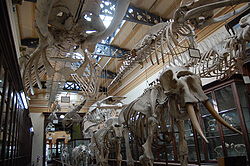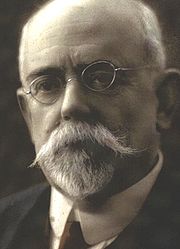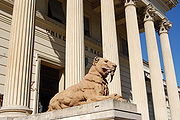
La Plata Museum
Encyclopedia

Natural history
Natural history is the scientific research of plants or animals, leaning more towards observational rather than experimental methods of study, and encompasses more research published in magazines than in academic journals. Grouped among the natural sciences, natural history is the systematic study...
museum in La Plata
La Plata
La Plata is the capital city of the Province of Buenos Aires, Argentina, and of La Plata partido. According to the , the city proper has a population of 574,369 and its metropolitan area has 694,253 inhabitants....
, Argentina
Argentina
Argentina , officially the Argentine Republic , is the second largest country in South America by land area, after Brazil. It is constituted as a federation of 23 provinces and an autonomous city, Buenos Aires...
.
The building, 135 meters (443 feet) long, today houses 3 million fossils and relics (including 44,000 botanical items), an amphitheatre
Amphitheatre
An amphitheatre is an open-air venue used for entertainment and performances.There are two similar, but distinct, types of structure for which the word "amphitheatre" is used: Ancient Roman amphitheatres were large central performance spaces surrounded by ascending seating, and were commonly used...
, opened in 1992, and a 58,000-volume library, serving over 400 university researchers. Around 400,000 visitors (8% of whom are from outside Argentina) pass through its doors yearly, including a thousand visiting researchers.
History

Francisco Moreno
Francisco Pascacio Moreno was a prominent explorer and academic in Argentina, where he is usually referred to as Perito Moreno...
to mount a display of his growing collection of anthropological
Anthropology
Anthropology is the study of humanity. It has origins in the humanities, the natural sciences, and the social sciences. The term "anthropology" is from the Greek anthrōpos , "man", understood to mean mankind or humanity, and -logia , "discourse" or "study", and was first used in 1501 by German...
, fossil
Fossil
Fossils are the preserved remains or traces of animals , plants, and other organisms from the remote past...
and bone findings at his family's Buenos Aires
Buenos Aires
Buenos Aires is the capital and largest city of Argentina, and the second-largest metropolitan area in South America, after São Paulo. It is located on the western shore of the estuary of the Río de la Plata, on the southeastern coast of the South American continent...
home in 1866, unwittingly laying the foundations for the future La Plata Museum.
Moreno spent the time between 1873 and 1877 exploring his country's then-remote and largely unmapped Patagonia
Patagonia
Patagonia is a region located in Argentina and Chile, integrating the southernmost section of the Andes mountains to the southwest towards the Pacific ocean and from the east of the cordillera to the valleys it follows south through Colorado River towards Carmen de Patagones in the Atlantic Ocean...
, becoming the first white Argentine to reach Lake Nahuel Huapi and what was later named Lago Argentino
Lake Argentino
Lago Argentino is a lake in the Patagonian , at . It is the biggest freshwater lake in Argentina, with a surface area of . It has an average depth of , and a maximum depth of ....
("Argentine Lake") and its imposing glacier (named Perito Moreno Glacier
Perito Moreno Glacier
The Perito Moreno Glacier is a glacier located in the Los Glaciares National Park in the south west of Santa Cruz province, Argentina. It is one of the most important tourist attractions in the Argentine Patagonia....
in his honor). The large body of man-made and paleontological
Paleontology
Paleontology "old, ancient", ὄν, ὀντ- "being, creature", and λόγος "speech, thought") is the study of prehistoric life. It includes the study of fossils to determine organisms' evolution and interactions with each other and their environments...
samples he gathered and carefully classified during this survey (which also led to the first border demarcation
Demarcation
Demarcation is the act of creating a boundary around a place or thing.Demarcation may also refer to:*Demarcation line, a temporary border between the countries...
treaty with neighboring Chile
Chile
Chile ,officially the Republic of Chile , is a country in South America occupying a long, narrow coastal strip between the Andes mountains to the east and the Pacific Ocean to the west. It borders Peru to the north, Bolivia to the northeast, Argentina to the east, and the Drake Passage in the far...
, in 1881) led to his establishment of the Buenos Aires Archaeological and Anthropological Museum in 1877.
Internationally respected naturalists such as Paul Broca
Paul Broca
Pierre Paul Broca was a French physician, surgeon, anatomist, and anthropologist. He was born in Sainte-Foy-la-Grande, Gironde. He is best known for his research on Broca's area, a region of the frontal lobe that has been named after him. Broca’s Area is responsible for articulated language...
and Rudolf Virchow
Rudolf Virchow
Rudolph Carl Virchow was a German doctor, anthropologist, pathologist, prehistorian, biologist and politician, known for his advancement of public health...
contributed valuable donations to the institution, which was incorporated into the Bernardino Rivadavia Natural Sciences Museum
Bernardino Rivadavia Natural Sciences Museum
The Bernardino Rivadavia Natural Sciences Museum is a public museum located in the Caballito section of Buenos Aires, Argentina.-History and overview:...
. The 1882 establishment of the city of La Plata
La Plata
La Plata is the capital city of the Province of Buenos Aires, Argentina, and of La Plata partido. According to the , the city proper has a population of 574,369 and its metropolitan area has 694,253 inhabitants....
as the new capital of the Province of Buenos Aires led the provincial legislature to requisition the collection in 1884 for the construction of a new facility set in a northside park, designed by renowned urbanist Charles Thays.

Its collections drew the attention of the world's anthropological community from the beginning, attracting numerous visiting international scholars. It earned the American Association of Museums
American Association of Museums
The American Association of Museums is a non-profit association that has brought museums together since its founding in 1906, helping develop standards and best practices, gathering and sharing knowledge, and advocating on issues of concern to the museum community...
' accreditation, as well as plaudits from one of the United States
United States
The United States of America is a federal constitutional republic comprising fifty states and a federal district...
' most prestigious naturalists at the time, Henry Augustus Ward
Henry Augustus Ward
Henry Augustus Ward was an American naturalist and geologist, born in Rochester, New York.After attending Williams College and the Lawrence Scientific School, Harvard, where he was an assistant of Louis Agassiz, he traveled in Egypt, Arabia, and Palestine, and studied at the Jardin des Plantes,...
, who deemed the museum to be the fourth most important of its kind in the world.

